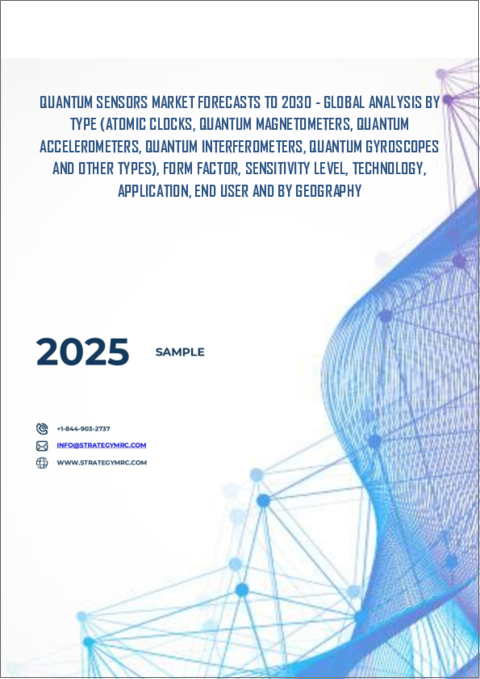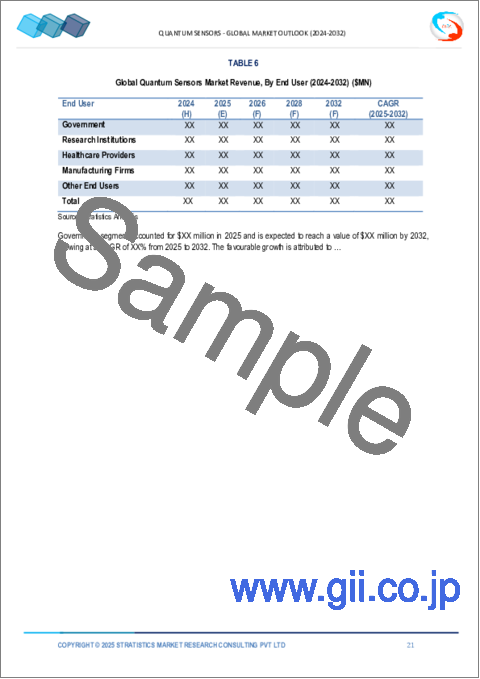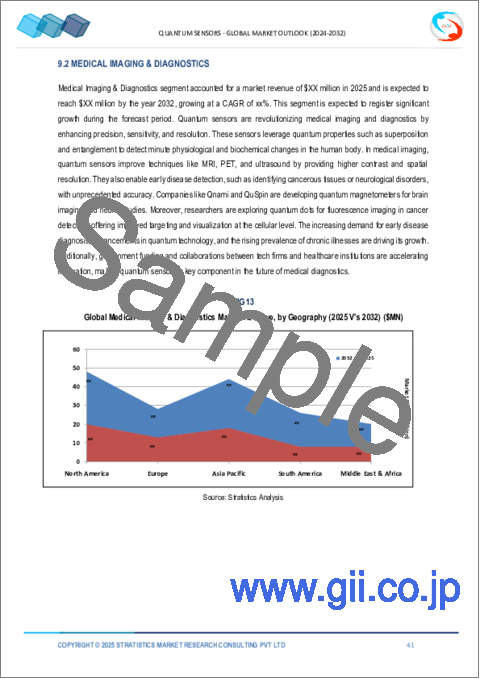|
|
市場調査レポート
商品コード
1587603
量子センサー市場の2030年までの予測: タイプ、フォームファクター、感度レベル、技術、用途、エンドユーザー、地域別の世界分析Quantum Sensors Market Forecasts to 2030 - Global Analysis By Type, Form Factor, Sensitivity Level, Technology, Application, End User and By Geography |
||||||
カスタマイズ可能
|
|||||||
| 量子センサー市場の2030年までの予測: タイプ、フォームファクター、感度レベル、技術、用途、エンドユーザー、地域別の世界分析 |
|
出版日: 2024年11月11日
発行: Stratistics Market Research Consulting
ページ情報: 英文 200+ Pages
納期: 2~3営業日
|
全表示
- 概要
- 図表
- 目次
Stratistics MRCによると、世界の量子センサー市場は2024年に5億2,000万米ドルを占め、予測期間中のCAGRは16.7%で成長し、2030年には12億5,000万米ドルに達すると予測されています。
量子センサーは、量子力学の原理を利用して磁場、温度、時間などの物理量を高感度かつ高精度に測定する先進的なデバイスです。量子センサーは、重ね合わせやエンタングルメントのような量子状態を利用して、古典的な限界を超えた測定能力を強化します。量子現象を利用することで、従来のセンサーでは実現できなかった精度の向上や新たな機能を提供します。
Quantum Valley Investments(QVI)によると、2023年、米国エネルギー省(DOE)は、核物理学に関連する量子情報科学(QIS)の13のプロジェクトに910万米ドルの資金提供を行うと発表しました。
精密測定への需要の高まり
ヘルスケア、通信、航空宇宙などの産業では、診断、信号処理、ナビゲーションなどの用途のために高精度のデータが必要とされています。量子センサーは比類のない感度と分解能を提供し、従来のセンサーでは捉えられなかった微細な変化の検出を可能にします。この精度の高さは、製品品質の向上、安全性の強化、様々なプロセスにおける性能の最適化につながります。産業界が技術革新や効率化のために正確な計測の価値を認識するにつれ、量子センサー技術への投資は増加し、市場の拡大や各分野での採用がさらに促進されると予想されます。
技術的な複雑さ
量子センサーは、重ね合わせやエンタングルメントといった量子力学の複雑な原理に依存しているため、技術的に複雑な問題を抱えています。これらのセンサーの設計と製造には、専門的な知識、高度な材料、精密な校正が必要であり、開発プロセスを困難なものにしています。さらに、実用的なアプリケーションで安定した量子状態を維持することは難しく、高度な冷却技術や遮蔽技術が必要となります。その結果、技術的な複雑さに伴う課題が市場全体の成長を鈍らせ、普及を制限する可能性があります。
ヘルスケア分野での応用拡大
高い感度と精度で知られる量子センサーは、微妙な生理学的変化の検出を可能にし、病気の早期診断と治療を促進します。例えば、磁気共鳴イメージング(MRI)や高度なイメージング技術に使用され、画像解像度を向上させています。さらに、これらのセンサーは、バイオマーカー検出やバイタルサインのリアルタイムモニタリングのアプリケーションをサポートしています。ヘルスケアの個別化・遠隔モニタリング・ソリューションの採用が進むにつれ、量子センサーの需要は拡大し、この分野での技術革新と投資が促進されると予想されます。
高い開発コスト
量子センサーは、その製造に複雑な技術と特殊な材料を必要とするため、高い開発コストがかかります。複雑な設計プロセス、高度な製造技術、製造時の管理された環境の必要性などが、こうした費用の一因となっています。さらに、量子技術の熟練した専門家の数が限られていることも、コストをさらに上昇させています。その結果、この金銭的な障壁が市場全体の成長を妨げ、量子センシング技術の革新ペースを鈍らせています。
COVID-19の影響
COVID-19パンデミックは、サプライチェーンを混乱させ、研究開発プロジェクトを遅らせることで、量子センサー市場に影響を与えました。しかし、同時にヘルスケア、特に診断やモニタリングにおける高度なセンシング技術の需要を加速させました。パンデミックの間、量子技術への投資が増加し、研究イニシアチブのための政府資金が成長に拍車をかけた。産業界が新たな課題に対応するにつれ、量子センサーはリモートセンシング、環境モニタリング、医療診断などの用途で支持を集め、市場の将来的な革新に道を開いています。
医療イメージング&診断分野が予測期間中最大になる見込み
メディカルイメージング&診断分野は、生物学的シグナルを検出する前例のない感度と精度により、予測期間を通じて最大の市場シェアを確保すると予測されています。これらのセンサーは高度なイメージング技術を可能にし、病気の早期発見や治療モニタリングの改善を促進します。量子レベルで動作する能力は解像度を高め、ノイズを低減し、より鮮明な画像と信頼性の高い診断につながります。この技術は、個別化医療や患者の予後改善に大きな期待が寄せられています。
予測期間中にCAGRが最も高くなると予想されるのは製造企業セグメント
予測期間中、CAGRが最も高くなると予測されているのは製造企業セグメントです。量子センサーは、精密測定や品質管理のために製造企業で採用されることが多くなっています。温度、圧力、磁場などの変数をリアルタイムでモニタリングできるため、生産効率や製品品質が向上します。さらに、量子センサーは自動化や予知保全を改善し、オペレーションの最適化、ダウンタイムの削減、大幅なコスト削減につながるため、製造業では貴重な資産となっています。
最大のシェアを占める地域
アジア太平洋地域は、研究開発への投資の増加、政府のイニシアティブ、量子技術の進歩により、予測期間中に最大の市場シェアを記録する見込みです。中国、日本、オーストラリアなどの国々が、ヘルスケア、通信、防衛などの分野で量子センサーの採用をリードしています。学術機関と産業界の協力体制がイノベーションを促進し、アジア太平洋地域は量子センサーの世界市場における主要プレーヤーとして位置づけられており、今後の発展が期待されています。
CAGRが最も高い地域:
北米は、量子技術への多額の投資と、特に米国とカナダからの強力な政府支援に後押しされ、予測期間中に最も高いCAGRを記録すると予測されています。北米は量子センサーの開発と商業化の中心地です。この地域の主要な研究機関や大学は、ヘルスケア、航空宇宙、防衛における革新的な量子センシング・アプリケーションを積極的に開発しています。高精度測定への需要の高まりと材料科学の進歩が市場拡大をさらに後押ししています。
無料カスタマイズサービス:
本レポートをご購読のお客様には、以下の無料カスタマイズオプションのいずれかをご利用いただけます:
- 企業プロファイル
- 追加市場プレイヤーの包括的プロファイリング(3社まで)
- 主要企業のSWOT分析(3社まで)
- 地域セグメンテーション
- 顧客の関心に応じた主要国の市場推計・予測・CAGR(注:フィージビリティチェックによる)
- 競合ベンチマーキング
- 製品ポートフォリオ、地理的プレゼンス、戦略的提携に基づく主要企業のベンチマーキング
目次
第1章 エグゼクティブサマリー
第2章 序文
- 概要
- ステークホルダー
- 調査範囲
- 調査手法
- データマイニング
- データ分析
- データ検証
- 調査アプローチ
- 調査情報源
- 1次調査情報源
- 2次調査情報源
- 前提条件
第3章 市場動向分析
- 促進要因
- 抑制要因
- 機会
- 脅威
- 技術分析
- 用途分析
- エンドユーザー分析
- 新興市場
- COVID-19の影響
第4章 ポーターのファイブフォース分析
- 供給企業の交渉力
- 買い手の交渉力
- 代替品の脅威
- 新規参入業者の脅威
- 競争企業間の敵対関係
第5章 世界の量子センサー市場:タイプ別
- 原子時計
- 量子磁力計
- 量子加速度計
- 量子干渉計
- 量子ジャイロスコープ
- その他のタイプ
第6章 世界の量子センサー市場:フォームファクター別
- ポータブル量子センサー
- 据置型量子センサー
第7章 世界の量子センサー市場:感度レベル別
- 高感度センサー
- 中感度センサー
- 低感度センサー
第8章 世界の量子センサー市場:技術別
- 超伝導量子干渉素子(SQUID)
- 光格子センサ
- 原子干渉計
- 単一光子検出器
- その他の技術
第9章 世界の量子センサー市場:用途別
- 医療画像診断
- 環境モニタリング
- ナビゲーションとポジショニング
- 石油・ガス探査
- プロセス制御
- その他の用途
第10章 世界の量子センサー市場:エンドユーザー別
- 政府
- 研究機関
- ヘルスケア提供者
- 製造業
- その他のエンドユーザー
第11章 世界の量子センサー市場:地域別
- 北米
- 米国
- カナダ
- メキシコ
- 欧州
- ドイツ
- 英国
- イタリア
- フランス
- スペイン
- その他欧州
- アジア太平洋
- 日本
- 中国
- インド
- オーストラリア
- ニュージーランド
- 韓国
- その他アジア太平洋地域
- 南米
- アルゼンチン
- ブラジル
- チリ
- その他南米
- 中東・アフリカ
- サウジアラビア
- アラブ首長国連邦
- カタール
- 南アフリカ
- その他中東とアフリカ
第12章 主な発展
- 契約、パートナーシップ、コラボレーション、合弁事業
- 買収と合併
- 新製品発売
- 事業拡大
- その他の主要戦略
第13章 企業プロファイリング
- IBM
- Boeing
- D-Wave Systems
- Microsoft
- Quantum Motion Technologies Limited
- Xanadu Quantum Technologies
- ColdQuanta
- Q-CTRL
- IonQ
- Alpine Quantum Technologies
- Quantum Design Inc.
- Rigetti Computing
- Terra Quantum
- PhotonQ
List of Tables
- Table 1 Global Quantum Sensors Market Outlook, By Region (2022-2030) ($MN)
- Table 2 Global Quantum Sensors Market Outlook, By Type (2022-2030) ($MN)
- Table 3 Global Quantum Sensors Market Outlook, By Atomic Clocks (2022-2030) ($MN)
- Table 4 Global Quantum Sensors Market Outlook, By Quantum Magnetometers (2022-2030) ($MN)
- Table 5 Global Quantum Sensors Market Outlook, By Quantum Accelerometers (2022-2030) ($MN)
- Table 6 Global Quantum Sensors Market Outlook, By Quantum Interferometers (2022-2030) ($MN)
- Table 7 Global Quantum Sensors Market Outlook, By Quantum Gyroscopes (2022-2030) ($MN)
- Table 8 Global Quantum Sensors Market Outlook, By Other Types (2022-2030) ($MN)
- Table 9 Global Quantum Sensors Market Outlook, By Form Factor (2022-2030) ($MN)
- Table 10 Global Quantum Sensors Market Outlook, By Portable Quantum Sensors (2022-2030) ($MN)
- Table 11 Global Quantum Sensors Market Outlook, By Stationary Quantum Sensors (2022-2030) ($MN)
- Table 12 Global Quantum Sensors Market Outlook, By Sensitivity Level (2022-2030) ($MN)
- Table 13 Global Quantum Sensors Market Outlook, By High Sensitivity Sensors (2022-2030) ($MN)
- Table 14 Global Quantum Sensors Market Outlook, By Medium Sensitivity Sensors (2022-2030) ($MN)
- Table 15 Global Quantum Sensors Market Outlook, By Low Sensitivity Sensors (2022-2030) ($MN)
- Table 16 Global Quantum Sensors Market Outlook, By Technology (2022-2030) ($MN)
- Table 17 Global Quantum Sensors Market Outlook, By Superconducting Quantum Interference Devices (SQUIDs) (2022-2030) ($MN)
- Table 18 Global Quantum Sensors Market Outlook, By Optical Lattice Sensors (2022-2030) ($MN)
- Table 19 Global Quantum Sensors Market Outlook, By Atomic Interferometers (2022-2030) ($MN)
- Table 20 Global Quantum Sensors Market Outlook, By Single-Photon Detectors (2022-2030) ($MN)
- Table 21 Global Quantum Sensors Market Outlook, By Other Technologies (2022-2030) ($MN)
- Table 22 Global Quantum Sensors Market Outlook, By Application (2022-2030) ($MN)
- Table 23 Global Quantum Sensors Market Outlook, By Medical Imaging & Diagnostics (2022-2030) ($MN)
- Table 24 Global Quantum Sensors Market Outlook, By Environmental Monitoring (2022-2030) ($MN)
- Table 25 Global Quantum Sensors Market Outlook, By Navigation & Positioning (2022-2030) ($MN)
- Table 26 Global Quantum Sensors Market Outlook, By Oil & Gas Exploration (2022-2030) ($MN)
- Table 27 Global Quantum Sensors Market Outlook, By Process Control (2022-2030) ($MN)
- Table 28 Global Quantum Sensors Market Outlook, By Other Applications (2022-2030) ($MN)
- Table 29 Global Quantum Sensors Market Outlook, By End User (2022-2030) ($MN)
- Table 30 Global Quantum Sensors Market Outlook, By Government (2022-2030) ($MN)
- Table 31 Global Quantum Sensors Market Outlook, By Research Institutions (2022-2030) ($MN)
- Table 32 Global Quantum Sensors Market Outlook, By Healthcare Providers (2022-2030) ($MN)
- Table 33 Global Quantum Sensors Market Outlook, By Manufacturing Firms (2022-2030) ($MN)
- Table 34 Global Quantum Sensors Market Outlook, By Other End Users (2022-2030) ($MN)
Note: Tables for North America, Europe, APAC, South America, and Middle East & Africa Regions are also represented in the same manner as above.
According to Stratistics MRC, the Global Quantum Sensors Market is accounted for $0.52 billion in 2024 and is expected to reach $1.25 billion by 2030 growing at a CAGR of 16.7% during the forecast period. Quantum sensors are advanced devices that leverage the principles of quantum mechanics to achieve high sensitivity and precision in measuring physical quantities such as magnetic fields, temperature, and time. They utilize quantum states, like superposition and entanglement, to enhance measurement capabilities beyond classical limits. By exploiting quantum phenomena, they offer improved accuracy and new functionalities that are not achievable with conventional sensors.
According to Quantum Valley Investments (QVI), in 2023, the U.S. Department of Energy (DOE) announced $9.1 million in funding for 13 projects in Quantum Information Science (QIS) with relevance to nuclear physics.
Market Dynamics:
Driver:
Increasing demand for precision measurement
Industries such as healthcare, telecommunications, and aerospace require highly accurate data for applications like diagnostics, signal processing, and navigation. Quantum sensors provide unmatched sensitivity and resolution, enabling the detection of minute changes that traditional sensors cannot capture. This heightened accuracy leads to improved product quality, enhanced safety, and optimized performance in various processes. As industries recognize the value of precise measurements for innovation and efficiency, investments in quantum sensor technology are expected to rise, further propelling market expansion and adoption across sectors.
Restraint:
Technical complexities
Quantum sensors involve technical complexities stem the intricate principles of quantum mechanics they rely on, such as superposition and entanglement. Designing and manufacturing these sensors require specialized expertise, advanced materials, and precise calibration, making the development process challenging. Additionally, maintaining stable quantum states in practical applications can be difficult, requiring sophisticated cooling and shielding techniques. Consequently, the challenges associated with technical intricacies can slow overall market growth and limit widespread adoption.
Opportunity:
Rising applications in healthcare
Quantum sensors, known for their high sensitivity and precision, enable the detection of subtle physiological changes, facilitating early disease diagnosis and treatment. For instance, they are used in magnetic resonance imaging (MRI) and advanced imaging techniques, improving image resolution. Additionally, these sensors support applications in biomarker detection and real-time monitoring of vital signs. As healthcare increasingly adopts personalized and remote monitoring solutions, the demand for quantum sensors is expected to grow, driving innovation and investment in this sector.
Threat:
High development costs
Quantum sensors incur high development costs due to the complex technology and specialized materials required for their fabrication. The intricate design processes, advanced manufacturing techniques, and need for controlled environments during production contribute to these expenses. Additionally, the limited availability of skilled professionals in quantum technology further elevates costs. Consequently, this financial barrier hampers overall market growth and slows down the pace of innovation in quantum sensing technologies.
Covid-19 Impact
The covid-19 pandemic impacted the quantum sensors market by disrupting supply chains and delaying research and development projects. However, it also accelerated demand for advanced sensing technologies in healthcare, particularly for diagnostics and monitoring. Increased investments in quantum technologies and government funding for research initiatives during the pandemic have spurred growth. As industries adapt to new challenges, quantum sensors are gaining traction in applications like remote sensing, environmental monitoring, and medical diagnostics, paving the way for future innovations in the market.
The medical imaging & diagnostics segment is expected to be the largest during the forecast period
The medical imaging & diagnostics segment is predicted to secure the largest market share throughout the forecast period thrived by its unprecedented sensitivity and accuracy in detecting biological signals. These sensors enable advanced imaging techniques, facilitating early disease detection and improved treatment monitoring. Their ability to operate at the quantum level enhances resolution and reduces noise, leading to clearer images and more reliable diagnostics. This technology holds significant promise for personalized medicine and enhanced patient outcomes.
The manufacturing firms segment is expected to have the highest CAGR during the forecast period
The manufacturing firms segment is anticipated to witness the highest CAGR during the forecast period. Quantum sensors are increasingly being adopted in manufacturing firms for precise measurements and quality control. They enable real-time monitoring of variables such as temperature, pressure, and magnetic fields, enhancing production efficiency and product quality. Additionally, quantum sensors can improve automation and predictive maintenance, leading to optimized operations, reduced downtime, and significant cost savings, making them valuable assets in the manufacturing industry.
Region with largest share:
Asia Pacific is expected to register the largest market share during the forecast period driven by rising investments in research and development, government initiatives, and advancements in quantum technology. Countries like China, Japan, and Australia are leading the way in adopting quantum sensors across sectors such as healthcare, telecommunications, and defense. Collaborative efforts between academic institutions and industries are fostering innovation, positioning the Asia-Pacific as a key player in the global quantum sensors market, with a promising outlook for future advancements.
Region with highest CAGR:
North America is projected to witness the highest CAGR over the forecast period propelled by significant investments in quantum technology and strong government support, particularly from the U.S. and Canada. North America has been a prominent hub for quantum sensor development and commercialization. The region's leading research institutions and universities are actively developing innovative quantum sensing applications in healthcare, aerospace, and defense. Increasing demand for high-precision measurements and advancements in materials science are further propelling market expansion.
Key players in the market
Some of the key players profiled in the Quantum Sensors Market include IBM, Google, Boeing, D-Wave Systems, Microsoft, Quantum Motion Technologies Limited, Xanadu Quantum Technologies, ColdQuanta, Q-CTRL, IonQ, Alpine Quantum Technologies, Quantum Design Inc., Rigetti Computing, Terra Quantum and PhotonQ.
Key Developments:
In September 2024, Boeing announced plans to launch its satellite named Q4S in 2026. This mission is significant as it aims to demonstrate quantum entanglement swapping in space, a crucial component for establishing a global quantum internet. Boeing's initiative is part of a broader effort to operationalize quantum technologies for a range of applications, including improved data collection regarding Earth and space environments.
In November 2023, Microsoft entered a strategic partnership with Photonic Inc. to enhance quantum networking capabilities. This collaboration aims to integrate scalable, fault-tolerant quantum technologies into Azure, facilitating reliable long-distance quantum communication and improving applications in various fields, including sensing and metrology.
Types Covered:
- Atomic Clocks
- Quantum Magnetometers
- Quantum Accelerometers
- Quantum Interferometers
- Quantum Gyroscopes
- Other Types
Form Factors Covered:
- Portable Quantum Sensors
- Stationary Quantum Sensors
Sensitivity Levels Covered:
- High Sensitivity Sensors
- Medium Sensitivity Sensors
- Low Sensitivity Sensors
Technologies Covered:
- Superconducting Quantum Interference Devices (SQUIDs)
- Optical Lattice Sensors
- Atomic Interferometers
- Single-Photon Detectors
- Other Technologies
Applications Covered:
- Medical Imaging & Diagnostics
- Environmental Monitoring
- Navigation & Positioning
- Oil & Gas Exploration
- Process Control
- Other Applications
End Users Covered:
- Government
- Research Institutions
- Healthcare Providers
- Manufacturing Firms
- Other End Users
Regions Covered:
- North America
- US
- Canada
- Mexico
- Europe
- Germany
- UK
- Italy
- France
- Spain
- Rest of Europe
- Asia Pacific
- Japan
- China
- India
- Australia
- New Zealand
- South Korea
- Rest of Asia Pacific
- South America
- Argentina
- Brazil
- Chile
- Rest of South America
- Middle East & Africa
- Saudi Arabia
- UAE
- Qatar
- South Africa
- Rest of Middle East & Africa
What our report offers:
- Market share assessments for the regional and country-level segments
- Strategic recommendations for the new entrants
- Covers Market data for the years 2022, 2023, 2024, 2026, and 2030
- Market Trends (Drivers, Constraints, Opportunities, Threats, Challenges, Investment Opportunities, and recommendations)
- Strategic recommendations in key business segments based on the market estimations
- Competitive landscaping mapping the key common trends
- Company profiling with detailed strategies, financials, and recent developments
- Supply chain trends mapping the latest technological advancements
Free Customization Offerings:
All the customers of this report will be entitled to receive one of the following free customization options:
- Company Profiling
- Comprehensive profiling of additional market players (up to 3)
- SWOT Analysis of key players (up to 3)
- Regional Segmentation
- Market estimations, Forecasts and CAGR of any prominent country as per the client's interest (Note: Depends on feasibility check)
- Competitive Benchmarking
- Benchmarking of key players based on product portfolio, geographical presence, and strategic alliances
Table of Contents
1 Executive Summary
2 Preface
- 2.1 Abstract
- 2.2 Stake Holders
- 2.3 Research Scope
- 2.4 Research Methodology
- 2.4.1 Data Mining
- 2.4.2 Data Analysis
- 2.4.3 Data Validation
- 2.4.4 Research Approach
- 2.5 Research Sources
- 2.5.1 Primary Research Sources
- 2.5.2 Secondary Research Sources
- 2.5.3 Assumptions
3 Market Trend Analysis
- 3.1 Introduction
- 3.2 Drivers
- 3.3 Restraints
- 3.4 Opportunities
- 3.5 Threats
- 3.6 Technology Analysis
- 3.7 Application Analysis
- 3.8 End User Analysis
- 3.9 Emerging Markets
- 3.10 Impact of Covid-19
4 Porters Five Force Analysis
- 4.1 Bargaining power of suppliers
- 4.2 Bargaining power of buyers
- 4.3 Threat of substitutes
- 4.4 Threat of new entrants
- 4.5 Competitive rivalry
5 Global Quantum Sensors Market, By Type
- 5.1 Introduction
- 5.2 Atomic Clocks
- 5.3 Quantum Magnetometers
- 5.4 Quantum Accelerometers
- 5.5 Quantum Interferometers
- 5.6 Quantum Gyroscopes
- 5.7 Other Types
6 Global Quantum Sensors Market, By Form Factor
- 6.1 Introduction
- 6.2 Portable Quantum Sensors
- 6.3 Stationary Quantum Sensors
7 Global Quantum Sensors Market, By Sensitivity Level
- 7.1 Introduction
- 7.2 High Sensitivity Sensors
- 7.3 Medium Sensitivity Sensors
- 7.4 Low Sensitivity Sensors
8 Global Quantum Sensors Market, By Technology
- 8.1 Introduction
- 8.2 Superconducting Quantum Interference Devices (SQUIDs)
- 8.3 Optical Lattice Sensors
- 8.4 Atomic Interferometers
- 8.5 Single-Photon Detectors
- 8.6 Other Technologies
9 Global Quantum Sensors Market, By Application
- 9.1 Introduction
- 9.2 Medical Imaging & Diagnostics
- 9.3 Environmental Monitoring
- 9.4 Navigation & Positioning
- 9.5 Oil & Gas Exploration
- 9.6 Process Control
- 9.7 Other Applications
10 Global Quantum Sensors Market, By End User
- 10.1 Introduction
- 10.2 Government
- 10.3 Research Institutions
- 10.4 Healthcare Providers
- 10.5 Manufacturing Firms
- 10.6 Other End Users
11 Global Quantum Sensors Market, By Geography
- 11.1 Introduction
- 11.2 North America
- 11.2.1 US
- 11.2.2 Canada
- 11.2.3 Mexico
- 11.3 Europe
- 11.3.1 Germany
- 11.3.2 UK
- 11.3.3 Italy
- 11.3.4 France
- 11.3.5 Spain
- 11.3.6 Rest of Europe
- 11.4 Asia Pacific
- 11.4.1 Japan
- 11.4.2 China
- 11.4.3 India
- 11.4.4 Australia
- 11.4.5 New Zealand
- 11.4.6 South Korea
- 11.4.7 Rest of Asia Pacific
- 11.5 South America
- 11.5.1 Argentina
- 11.5.2 Brazil
- 11.5.3 Chile
- 11.5.4 Rest of South America
- 11.6 Middle East & Africa
- 11.6.1 Saudi Arabia
- 11.6.2 UAE
- 11.6.3 Qatar
- 11.6.4 South Africa
- 11.6.5 Rest of Middle East & Africa
12 Key Developments
- 12.1 Agreements, Partnerships, Collaborations and Joint Ventures
- 12.2 Acquisitions & Mergers
- 12.3 New Product Launch
- 12.4 Expansions
- 12.5 Other Key Strategies
13 Company Profiling
- 13.1 IBM
- 13.2 Google
- 13.3 Boeing
- 13.4 D-Wave Systems
- 13.5 Microsoft
- 13.6 Quantum Motion Technologies Limited
- 13.7 Xanadu Quantum Technologies
- 13.8 ColdQuanta
- 13.9 Q-CTRL
- 13.10 IonQ
- 13.11 Alpine Quantum Technologies
- 13.12 Quantum Design Inc.
- 13.13 Rigetti Computing
- 13.14 Terra Quantum
- 13.15 PhotonQ





